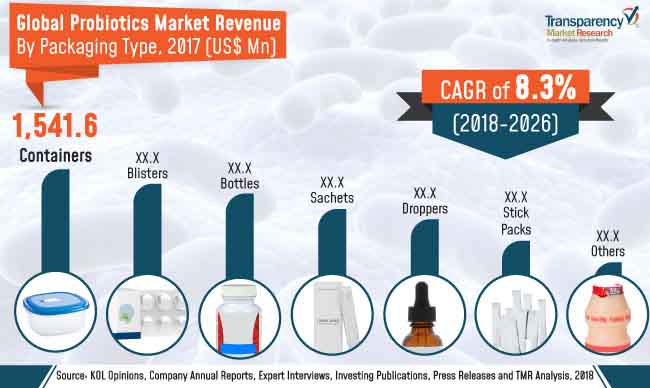
As an impact of busy, modern lifestyle, the consumption of healthy food among humans has been limited, and at times, individuals disturb the delicate balance of the body’s intestinal flora, which can cause occasional gastrointestinal discomfort, and infection in other body parts. Therefore, a healthy balance of intestinal flora and infection control can be supported through the consumption of food or food supplement products that contain friendly live bacteria cultures, commonly referred to as ‘probiotics’. Probiotics are live micro-organisms, when administered in adequate amount confer a health benefit on the host”, is the standard definition provided by the Food and Agriculture Association (FAO) of the United Nations. These friendly and live bacteria, when administered to and/or consumed by humans in the non-food form, are referred to as ‘probiotic supplements’, which are generally available either in the form of tablets, capsules, powder, liquid, chewables, and others.

Request Sample pages of premium Research Report – https://www.transparencymarketresearch.com/sample/sample.php?flag=B&rep_id=386
The global revenue generated from Probiotics market is estimated to be valued at roughly US$ 6,762.2 Mn by the end of 2018 and is expected to increase at a CAGR of 8.3% over the forecast period. Global Probiotics market are expected to be valued at approximately US$ 12,753.4 Mn by the end of 2026.
Key Drivers & Restraints Impacting the Market Performance through 2026
Consumption of antibiotics per capita is increasing on the backdrop of the increase in healthcare expenditure and out of pocket pharmaceutical spending. Low and middle income countries are growing in terms of per capita disposable income, and this factor is boosting antibiotic consumption in these countries. Furthermore, favorable policies to push antibiotics in these countries have amplified the usage of antibiotics in some of these countries. Excessive usage of antibiotics by an individual results in imbalance of microbiota, and also lowers the bacterial diversity as well as overall bacterial count in the gut.
Harmful effects of excess antibiotic consumption has been reported, necessitating the additional supplementation of friendly bacteria into the body. Some of these bacteria have also developed antibiotic resistant characteristics, and do not respond to the consumed antibiotics. It is thus important to replenish such bacteria in the body, thus nucleating targeted bacterial strain consumption. A larger chunk of such population relying on antibiotics has absorbed the importance of probiotic supplements, and have started consuming them. The consumption of antibiotics has shown a significant rise in BRICS countries in the last decade; some antibiotics are available over the counter in these countries. Needles to says, probiotic supplement manufacturers have also adopted a targeted approach in these countries, and have invested in marketing efforts. These factors collectively are expected to support the overall demand for probiotic supplements across the globe.
More Trending Reports by Transparency Market Research – https://www.prnewswire.com/news-releases/global-pet-food-market-to-show-an-impressive-cagr-of-6-from-2019-to-2029-with-valuation-expected-to-reach-us-168-3-bn-finds-tmr-300999294.html
Market Taxonomy on the Basis of Form, Packaging Type, & Distribution Channel
By form, the Probiotics market is segmented into dry and liquid. The dry segment is further sub-segmented as tablets/ caplets, capsules, powder/ granules and chewables. The dry segment is likely to be the most attractive segment in the forecast period owing to the availability of larger product variants coupled increasing product offerings in powder/granule format.
On the basis of packaging type, the Probiotics market can be segmented into blisters, bottles, containers, sachets, stick packs, droppers and others. Among all these segment the containers segment is estimated to account for a significant revenue share of 24.7% in 2018 and is expected to register significant growth rate during the forecast period. However the bottle segment is expected to register comparatively largest CAGR growth of 8.7% during the forecast period.
Furthermore, on the basis of distribution channel, the Probiotics market is segmented into hypermarkets/ supermarkets, pharmacies/ drugstores, specialty stores and online sales.
Request for Discount on This Report at – https://www.transparencymarketresearch.com/sample/sample.php?flag=D&rep_id=386
Analysis of Key Regional Markets & Key Market Players
On the basis of region, the market in North America and Europe is expected to dominate in terms of value share over the forecast period followed by Asia Pacific. Asia pacific is expected to become a prominent market by the end of the forecast period with a significant CAGR attributed to increase in product penetration and rising awareness through various promotional activities.
Some of the major companies operating in the global Probiotics market are Chr. Hansen Holding A/S, BioGaia AB, Probi AB, Nestlé S.A., DowDuPont Inc., The Procter & Gamble Company, Probiotics International Limited, Lallemand Inc. Pfizer Inc., PharmaCare Laboratories, Dr. Willmar Schwabe Group, SymbioPharm GmbH and others.
Request for covid19 Impact Analysis – https://www.transparencymarketresearch.com/sample/sample.php?flag=covid19&rep_id=386





